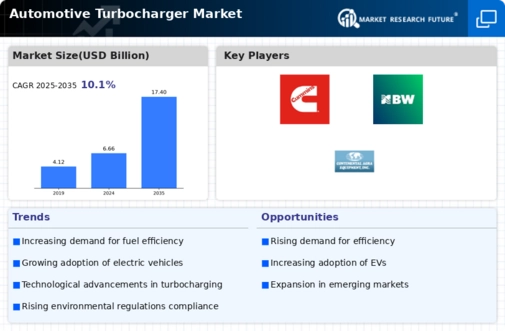Automotive Turbocharger Size
Automotive Turbocharger Market Growth Projections and Opportunities
The automotive turbocharger market is shaped by several market factors that significantly influence its growth trajectory and dynamics. One crucial factor impacting this industry is the increasing emphasis on fuel efficiency and emission regulations. With rising emission standards in governments across the globe, automotive manufacturing companies are asked to create cars that have better fuel efficiency and lesser pollutants. Turbochargers are now an essential part in meeting such strict regulations because it enhances the efficiency and power of engines without necessarily affecting fuel consumption. They then drive up demand for turbo charged vehicles.
The growth in the production of small engines is another important factor that determines the market. Automakers are shrinking engine sizes while attempting to retain or improve performance. Turbochargers are critical in enhancing the power potential of these downsized engines. Major factors underscoring the trend toward down-sizing and consumers wanting more potent yet fuel efficient vehicles, turbocharged engines continue to be incorporated into a wide range of vehicle classes.
Another important factor affecting the automotive turbocharger market is technological developments in design and materials of a turbocharger. Developments in turbocharger technology are centered on improving performance, reducing turbolag and maximizing efficiency. With advanced materials and manufacturing processes, turbochargers become more durable and efficient to meet the demands for being highly reliable with longer life-smans. Moreover, the incorporation of electronic actuators and controls into turbochargers makes them more responsive and efficient while meeting consumer demands for seamless driving.
The aftermarket sector also plays a crucial role in the automotive turbocharger market. The growing aftermarket demand for turbochargers comes from car owners who want to improve their cars in terms of performance. Aftermarket turbocharger kits are often chosen by enthusiasts and tuners to increase the power of an engine beyond factory specifications. Additionally, since older models need replacements or enhancements the aftermarket segment acts as an ongoing driver of growth in turbocharger market.
Amongst economic factors, those that influence the market for turbocharged vehicles include consumer purchasing power and ability to dispose of income. Turbochargers usually cost more to buy compared with naturally aspirated engines, but provide better performance and fuel efficiency. Market demand depends on economic stability and consumer willingness to invest in vehicles with turbochargers mounted. Also, fluctuations in fuel prices affect the popularity of turbocharged vehicles as consumers weigh long-term saving against initial investment costs.
Automotive Turbocharger Market is also influenced by geographical variations in emission standards, vehicle preferences, and economic conditions. Places with strict emission regulations are characterized by higher demand for turbocharged automobiles because of their ability to comply with such standards efficiently. Further, consumer demand for high-performance vehicles varies globally and affects the acceptability of turbocharged engines in different regions.
Competition within the automotive turbocharger market is a significant factor driving innovation and market growth. Various turbocharger manufacturers compete based on product offerings, pricing strategies, and technological advancements. Continuous research and development initiatives to create more efficient, reliable, and cost-effective turbocharging solutions contribute to the competitive landscape. Furthermore, partnerships between turbocharger manufacturers and automotive OEMs play a crucial role in market expansion and technology integration.








Leave a Comment